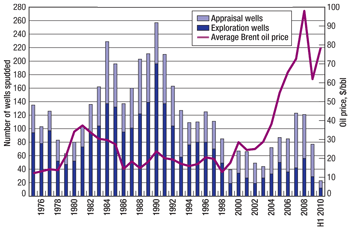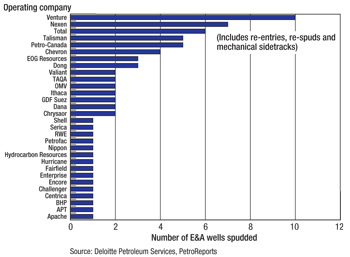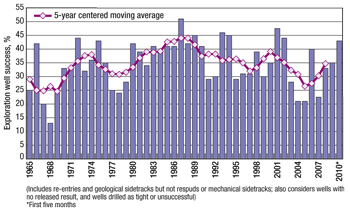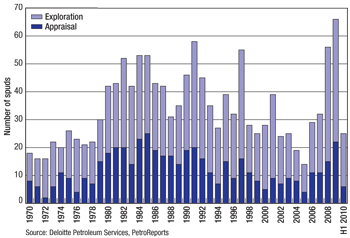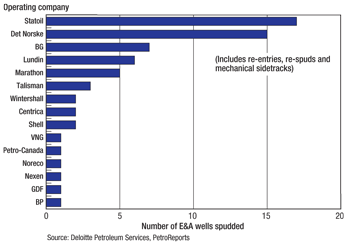A favorable tax regime has helped operators in Norway weather the storm, and recent oil price stability seems to be ramping up UK activity as well.Matthew Evans and Paul Froydenlund, Deloitte Petroleum Services, UK Increased economic stability over the last year has boosted activity in the North Sea, with previously shelved projects being reinstated. After record numbers of license offers in the UK’s 25th licensing round, the records were broken again with the 26th round, albeit after an initial delay. However fewer companies are vying for the licenses. Previously underexplored license areas have been offered, and a new nine-year frontier exploration license has been included in the hope of attracting long-term investments. Corporate deals have remained prevalent as companies continue to consolidate their financial positions via mergers and acquisitions. So far, 2010 has seen a steady increase in farm-in deals, as development plans restart and companies look to share risk. In the UK, drilling trends seen in 2009 have continued into first-half 2010, with exploration and appraisal activity down compared to the 10-year highs seen in 2007 and 2008. Conversely, in the Norwegian sector companies have benefited from a favorable tax regime, and the sector has seen record high levels of exploration. Activity on the Norwegian Continental Shelf (NCS) in 2010 is keeping pace with 2009 levels. Looking toward the second half of the year, the recent stability of oil prices may encourage increased drilling in the UK and, indeed, the whole of North West Europe. After a slow start to 2010 on the UK Continental Shelf (UKCS), operators have kicked off their drilling campaigns, with the total number of exploration projects on course to eclipse those of 2009. UNITED KINGDOM After a delay in 2009, then-Energy and Climate Change Minister Philip Hunt announced in January 2010 that the Department of Energy and Climate Change (DECC) was inviting applications for licenses in the 26th offshore licensing round. This is the first time that blocks have been offered in all regions of the UK, with acreage available in the West of Shetland, northern North Sea, central North Sea, southern North Sea, Irish Sea and Morecambe Bay, West of Hebrides, South West Approaches and the English Channel. Fourteen blocks that had been classified as fallow in 2009 have been offered in this round, as have the majority of blocks licensed in the first round of 1964 that were not granted extensions. The 26th round offered a record 2,818 blocks or partial blocks. This year, the government introduced a new frontier license with an extended nine-year exploration term for the West of Shetland region (blocks west of 7°W). It is hoped that this new license, along with a potential ₤160 million of tax relief for each qualifying field, will encourage development of some of the new discoveries made in the area. As in previous rounds, traditional, frontier and promote licenses are also available in eight Strategic Environmental Assessment (SEA) areas. DECC also announced the 17 blocks and six discoveries included in the 11th release of the fallow process. There are 17 new “Fallow B”-class block sub-areas published, which classification means they must have significant plans for activity approved by DECC or be relinquished by Dec. 31, 2010. Many of these blocks include producing fields or discoveries, but it is the area outside the field or discovery area that now needs significant activity. Eight of these blocks were on older licenses issued before the fifth round. Since the fallow process began in 2002, 112 exploration or appraisal wells targeting prospects on Fallow B blocks have been drilled. In 2009, drilling began on five exploration or appraisal wells targeting prospects on previously fallow blocks or sub-areas. Deal activity. After the continued economic slump during the first six months of 2009, the second half of the year saw more sustained economic stability, albeit at a low-level plateau. However, smaller independent oil and gas companies continued to pursue consolidation of their financial assets via monetization of their non-core portfolios or via mergers. In the last 12 months, large-scale international deals have remained a prominent feature; 25 deals involved assets across more than one country. Significant international corporate-level deals included Bayerngas’ acquisition of Genesis Petroleum and San Leon’s proposal to Island Oil & Gas for the combination of the two companies. On an asset level, Q4 2009 saw agreements on international asset swaps by Cairn and Dyas and by Shell and Hess. First-quarter 2010 has reflected a significant drop in international deal activity compared with Q4 2009, reflecting the increased feeling of financial comfort in the industry. In the UK, 11 corporate deals were announced or completed in the last 12 months. In contrast to the drop in large-scale international deals, the volume of UK corporate deals has gradually increased since Q3 2009, in which only one deal was completed, to nine deals in first-half 2010. Venture had a tumultuous few weeks in Q3 2009 resulting in Centrica completing its cash offer for the company. Reorganizations and divestitures on a corporate level became prevalent in Q1 2010, with both Endeavour and Bridge Resources looking for strategic alternatives for their assets. Meanwhile, Lundin sought stabilization by spinning off its UK business into the newly formed company EnQuest. The usually buoyant asset acquisition market in the UK has seen a slight decline over the last 12 months. Ithaca has remained particularly active, being involved in three of the four deals announced and completed in Q4 2009. Velo Energy had a roller-coaster few months in Q1 2010 when DECC announced that it would consider transfers of non-operated license interests in the North Sea, after a previous letter stated that transfers would not be considered. With this news, Velo entered Premier’s Caledonia and Sheryl Fields in the North Sea. Changes in farm-in and asset divestiture activity during the last 12 months have been an indication of the economic recovery. Second-half 2009 saw the number of asset divestitures announced trump the number of farm-ins agreed upon, as companies continued to tighten their belts. However, in first-half 2010, companies have begun to reinstate development plans that were put on hold. As an effect of this, farm-in agreements have exceeded asset acquisitions, with companies looking to share risk on current drilling prospects. Exploration and appraisal drilling. A total of 77 exploration and appraisal wells were spudded on the UK Continental Shelf in 2009, representing a 36% decrease in drilling from 2008’s total of 121 wells. The percentage of spuds drilled as appraisal wells increased to 62%, as exploration drilling dropped to the lowest levels in six years. Indications for first-half 2010 suggest a continued decrease in E&A drilling; by June, only 23 wells had been drilled, compared with 31 for the same period in 2009. It is anticipated that exploration activity will increase with sustained stability in the oil price. Historically, a broad downward trend in drilling frequency was seen on the UKCS from the mid-1990s until 2003, after which the increasing oil prices of 2002–2008 caused drilling to rebound, Fig. 1. The steep oil price decline and market volatility from late 2008 into 2009, and the resultant capital constraints across the industry, led to reduced drilling during that period. For the remainder of 2010, drilling is expected to gather pace, thanks to sustained monthly oil price averages over $60/bbl since June 2009. This buoyancy in the oil price is likely to restore the faith of investors and exploration managers and may lead to more capital outlay for E&A projects.
Figure 2 highlights how companies operating in the UK have taken differing approaches to drilling activity since mid-2009. From the end of June 2009 through June 2010, 10 discoveries were announced on the UKCS.
In the northern North Sea, Total achieved a successful oil discovery at Balvenie. The discovery well, 3/14d-18, was spudded last June and encountered oil, although its potential for commercial production is yet to be assessed. Also in the northern North Sea, Valiant Petroleum made a discovery at its East Tybalt prospect. Well 211/8c-4 targeted a four-way dip closure enhanced by a stratigraphic pinchout. The prospect had gross probable (P50) oil reserves of 35.6 million bbl within a Magnus sandstone reservoir. A 278-ft gross oil column was encountered. The reservoir was cored, and data is being analyzed with a view to determine net pay over the section. A subsequent sidetrack (211/8c-4z), targeting the West Tybalt structure, encountered light oil within a four-way dip structure, with net pay of 100–200 ft. Initial analysis suggests that the sidetrack has located better reservoir quality than the parent well. If deemed commercial, both fields would be developed as subsea tiebacks to local host infrastructure, such as at Magnus Field, the Don Fields, Thistle Field or through the Penguin Field facilities. In the Moray Firth, Apache made a discovery on an extension of Forties Field with exploration well 21/10-A52. The well encountered 49 ft of net pay in Eocene sands. The pay zone was found about 492 ft above the main Forties reservoir; preliminary estimates suggest In the southern North Sea, Venture drilled Well 48/15b-10 to target the Leman sandstone on its Andrea prospect. The well discovered gas within the upper sands, but it is considered tight and unlikely to flow without stimulation. Also in the southern North Sea, Centrica made the Olympus gas discovery with Well 48/12e-11, targeting the Lower Permian-aged Leman sandstones. The well, whose initial geologic chance of success was 38%, went on to encounter an accumulation with P50 reserves of 123 Bcf in the Lower Leman and 83 Bcf in the Upper Leman sandstone. Dana’s Well 48/1a-5 encountered what the company has called a “significant gas discovery” at the Platypus prospect in April 2010. The well passed 218 vertical ft of good-quality, gas-bearing sands before reaching total depth. The discovery is thought to be in line with the initial estimates of 130 Bcf of gas in the Rotliegend and Lower Leman sandstones. The well has been suspended, with the possibility that it may be used as a gas producer. Within the West of Shetland Basin, Dong achieved success with two wells, 214/30a-2 and 214/30a-2z, which both encountered gas at the Glenlivet prospect. Well 214/30a-2 was drilled as part of the license obligation and targeted the Late Palaeocene-aged Vailia Formation. The well encountered gas within a stratigraphic trap, with a reservoir of notably high permeability and overall quality. The Glenlivet sidetrack successfully defined the lateral extent of the initial discovery and allowed Dong to surpass the pre-drill expectation of net gas column and reservoir quality. In the East Irish Sea, the Rhyl prospect was tested with Well 113/27b-6 by Centrica and discovered gas at the Sherwood sandstone level. The well was drilled to 5,905 ft TD, encountering 150 Bcf within a rotated fault block. Well 113/27b-6 was tested and produced flowrates of about 14 MMcfd. If developed, the field is likely to be tied back to existing infrastructure nearby. In the first five months of 2010, 43% of classified wells on the UKCS have been deemed a success—i.e., classified by the operator as an oil, gas or condensate well, or any combination thereof. However, because many of the wells drilled have yet to be classified by the operator, the true figure is likely to vary. Nonetheless, the 2010 success rate to date exceeds a five-year moving average of about 35%, Fig. 3. The economic climate over the last two years may have contributed to this increase, as companies shelved higher-risk projects that were less certain to deliver a return on capex. However, it is important to note that there are many reasons for well success, involving complex geological and mechanical conditions.
Development and production. Second-half 2009 saw one more field brought online than in the first half, with three oil fields and one gas field starting production. However, this trend has not continued into 2010, the Lochranza oil field being the only field to come onstream in the first half. Affleck Field came onstream on Aug. 17, 2009. The discovery well drilled by Shell in 1975 encountered oil and gas in a Cretaceous Tor Formation reservoir. The field was developed using two sub-horizontal production wells tied back to the Janice floating production unit. The development involved a 28-km flowline to tie back Affleck to Janice and the construction of a new gas export spurline to the Clyde platform. Ettrick Field came onstream two days before Affleck, on Aug. 15. After its discovery in 1981, an initial development attempt failed in 1986. First oil was originally due in Q1 2008; however, this was pushed back to 2009 after commissioning delays in Singapore on the lease of the FPSO Aoka Mizu. The Shelley oil field, discovered in 1984, came onstream on Aug. 6, 2009. The field has been developed using two horizontal subsea production wells equipped with downhole ESPs. The wells are connected via a short flowline and a control umbilical to the Sevan Voyageur, a cylindrical FPSO. Since production began, reservoir pressure has fallen significantly and the watercut has risen much more quickly than expected. The only gas field to come onstream in second-half 2009 was Topaz, on Nov. 19. The field was discovered in 1987 with a well that targeted the Leman and Westphalian sandstones. The field life is estimated to be eight to nine years. However, Topaz relies on the Caister Murdoch system of fields (CMS), so production will cease in line with the CMS project. Lochranza came onstream on Jan. 1, and peak production is expected in 2011. The field, formally known as Plada, was discovered by Conoco in 1992 and was appraised by Maersk in 2006. Development well drilling and facility installation commenced in 2009, with three development wells drilled in April of that year. Two further development wells were drilled in January 2010. NORWAY The Norwegian Petroleum Directorate (NPD) received applications from 44 companies for last year’s Awards in Predefined Areas (APA), comprising a total of 227 blocks covering 55,319 sq km. The acreage announced has increased since 2008, due to a large number of relinquishments over the year. However, the number of companies applying for acreage decreased from 47 in 2008. In Q3 2009, NPD announced that it is offering a total of 38 production licenses under APA 2009—25 in the North Sea, 10 in the Norwegian Sea and three in the Barents Sea. Of the 44 companies that applied, 42 have been offered licenses. Operatorships have been offered to 19 companies, of which only Bridge and Repsol have not previously been operators on the NCS. The Ministry of Petroleum and Energy also announced APA 2010, with blocks available for application in the North Sea, the Norwegian Sea and the Barents Sea. The area available is larger than in APA 2009, with the new additions located in the Norwegian Sea and the Barents Sea. In the last 12 months, Norwegian corporate deal activity has been minimal, with only two deals announced. Det Norske’s merger with Aker Exploration, originally announced in Q3 2009, was completed in Q1 2010. North Energy also entered an agreement involving its acquisition of all 4sea Energy shares. Deal activity on an asset level has stayed relatively consistent in Norway. Twelve deals were announced and completed in the last 12 months, versus 13 deals in the previous 12 months. Of the 15 separate companies involved in these transactions, Spring Energy has been the busiest. Spring reached an agreement to acquire an interest in production license 377S from Idemitsu and agreed to two separate deals with Wintershall, including a swap deal involving nine licenses. Along with the slight drop in asset acquisition activity, farm-in activity in Norway has seen a similar decline. Five farm-in deals were agreed upon, involving seven companies. Lundin made farm-in deals with both Centrica and Bayerngas, while Noreco agreed to two farm-in deals with Sagex and Svenska. Exploration and appraisal drilling. In stark contrast to the UK’s marked downward trend in 2009, Norway saw the largest ever number of E&A wells drilled on the NCS last year—66, a 16% increase compared to the 56 wells spudded in 2008, Fig. 4. This unprecedented high level of drilling activity in the face of some of the greatest oil price volatility in a decade was likely encouraged by the 78% tax rebate that is being offered by the Norwegian government for any dry holes drilled. That move has strengthened the confidence of investors in an otherwise uncertain economic climate. Two-thirds of Norway’s wells drilled in 2009 were exploration wells, roughly in line with the percentage in 2008. In first-half 2010, 25 E&A wells were drilled on the NCS, a decrease of 20% compared with the same period in 2009.
Statoil’s activity remains high across the NCS, Fig. 5. In the 12 months ending in June 2010, the majority state-owned Norwegian oil firm made three discoveries in the Norwegian Sea at Idun North, Gygrid and Gjok Fields. Well 6407/8-5 A was drilled at Gygrid to delineate the discovery made with Well 6407/8-5 S, which encountered an oil column in the Lower Jurassic. Well 6407/8-5 A encountered further accumulations in the Middle Jurassic, causing the preliminary estimates for total recoverable oil to be placed at 20–30 million bbl. It has been suggested that the discovery may be tied back to Njord and extend the commercial life of that field, which is now in the tail end of its production life.
Statoil’s Well 6507/3-7 at the Idun prospect, located 12 km north of the Skav discovery, successfully proved the presence of gas in the Middle Jurassic Fangst group. The well reached a TD of 12,575 ft in the Are Formation. Provisional estimates indicate between 20 and 100 Bcf of recoverable gas in place. Finally, Well 6507/3-8, targeting a Gjok Formation reservoir, successfully encountering a 469-ft oil column within the Lower Jurassic Fangst and Bat groups. The reservoir properties are understood to be of a high standard, with an estimated 46–53 Bcf of recoverable gas in place. Statoil also made two discoveries in the Norwegian portion of the North Sea. The Omega Nord 34/4-12 S well proved a small oil column within a poor-quality sand and shale unit. The well reached 9,645 ft TD in the Triassic Lunde Formation, but the accumulation is not thought to be commercially recoverable. In contrast, at Well 25/2-17 near the Frigg Fields, Statoil discovered a “commercially interesting” volume of oil in the range of 18–35 million bbl. This volume combined with those of the nearby Frigg and Grigg Epsilon reservoirs brings the total potential recoverable volume in the area to between 62 and 189 million boe. Marathon reported three successes in the Norwegian sector of the North Sea, at South Kneler, Viper and Marihone Fields. In October 2009, the company completed discovery well 24/9-9 S, which encountered oil in the Hermod sandstone. The size of the discovery has been estimated at 20–30 million boe. The well and all its associated sidetracks are thought to be in pressure communication, increasing the potential upside. The discovery of oil at Viper marked an additional success for Marathon with Well 25/4-10 S targeting the Hermod Formation. Marathon subsequently sidetracked the Viper discovery well; Well 25/4-10 A was drilled to 7,109 ft TVD and encountered gas within the Lista sands, just above the Heimdal Formation. The reservoir is said to be disappointingly thin, but development is being considered across to the nearby Gekko gas field. VNG Norge drilled Well 35/3-7 S on the Cyclops prospect, 2 km southwest of Agat Field and 50 km north of Gjoa Field. The well proved gas within the Lower Cretaceous Agat sandstone with recoverable gas estimates of 100–300 Bcf. This was the second well drilled in production license 270, and the first to be drilled by VNG Norge. Also in the Norwegian North Sea, Petro-Canada hit oil at its Beta prospect with Well 34/4-11, about 15 km north of Snorre. The well, which targeted the high-quality Brent and Statfjord sandstones, has preliminary recoverable oil estimates of 44–252 million bbl. Det Norske, whose drilling activity on the NCS has rivaled Statoil’s in the 12 months ending in June 2010, achieved success with three wells, one at the Jetta prospect and two at Storklakken Field. Jetta exploration well 25/8-17 and its associated sidetracks, targeting Palaeocene reservoir units, were drilled by Det Norske on behalf of block operator ExxonMobil. Oil was encountered, but the reservoir thickness was less than anticipated in pre-drill estimates. The proximity of Jetta to existing production facilities will increase the likelihood of this prospect being brought into development. Situated between Frigg and Vale Fields, the Storklakken discovery was made with Wells 25/1-11 and 25/1-11 A. The parent wellbore encountered a 30-ft oil column in the upper part of a sandstone unit within the Frigg Formation. The sidetrack was drilled upflank toward the top of the structure, and proved further reserves in a 62-ft oil column and a 3-ft gas column, besides the parent well’s reserves. Lundin made an oil discovery with Well 16/1-12, targeting an extension of Luno Field. Instead of the Pre-Cretaceous reservoir of Luno Field, the well encountered an oil accumulation in a fractured basement reservoir. The gross oil column is about 130 ft thick, with good flows confirmed from drill stem tests. The commerciality and resource potential are being assessed. Development and production. Despite the recent stabilization of the economic climate, development plans in Norway that were previously on hold and are slowly being reinstated have not yet caused a resumption of production startups. Only two Norwegian fields have come onstream in the last 12 months. Tyrihans Field in the Norwegian Sea came onstream on July 9, 2009, and has been developed with four subsea templates for production and gas injection and one subsea template for seawater injection. The field is tied back to the Kristin production semisubmersible, where gas is exported via Kristin and the Åasgard transport trunkline to Karsto for progressing. Oil and condensate are combined with Kristin output and transported to the Åasgard-C storage vessel for export by shuttle tanker. Volund Field in the North Sea came onstream on Sept. 10, 2009. The field has been developed with four subsea wells tied into the Alvheim FPSO. From there, the crude oil is then exported via shuttle tankers while the associated gas is tied into the UK’s Scottish Area Gas Evacuation (SAGE) line to THE NETHERLANDS License offers in the Netherlands have remained sporadic in the last year. The Ministry of Economic Affairs invited applications for exploration licenses in Blocks D/12b, M/4 and L/11c. Three license awards have been announced in the last year. In July 2009, PA Resources, together with its partner Smart Energy Solutions (SES), was awarded the Schagen license. Northern Petroleum gained two licenses, the first of which—exploration license Engelen—covers the Kerkwijk South gas prospect in the West Netherlands Basin. The second license—the Zuid-Friesland III production license—was awarded to Nederlandse Aardolie Maatchappij (NAM), Total, Petro-Canada and Dyas. Under separate prior agreements, Northern Petroleum will acquire NAM’s and Dyas’ working interests in the license and assume operatorship. On a corporate level, one acquisition, one merger and one divestiture have been announced in the last 12 months. In Q3 2009, Abu Dhabi National Energy Co. completed its acquisition of Royal DSM in Q3 2009, and Vattenfall and Nuon completed their merger. In Q1 2010, Petro-Canada announced that it was assessing the market for the sale of its Dutch subsidiary Petro-Canada Nederland BV. The Netherlands has seen two asset acquisitions announced in the last 12 months, both of which involved Cirrus Energy. The Canadian energy company acquired an interest in the L11b-A gas field, platform and pipeline connections to the NGT trunk pipeline system and an interest in the production platform that services the L8-D gas field. Though no farm-in agreements were made over the past 12 months, Elko Energy announced that it is continuing to look for farm-in partners for Block P/2. Stratic Energy announced that it intends to farm out its interests in the southern F-quadrant and in Block L1b. GDF drilled Well L/5-12 targeting the Bunter sandstone and encountered high gas pressures. The well was drilled 8 km east of the GDF-operated L05-FA Field. Disappointingly, logs indicate that the reservoir has fair to poor permeability and porosity, possibly due to salt plugging. DENMARK Licensing and deal activity in Denmark has been negligible in the last 12 months. The Danish Energy Agency granted two new licenses under the Open Door Procedure. The licenses, 1/09 and 2/09, were both granted to Danica Jutland (80%) and Nordsøfonden (20%). A single farm-in transaction was agreed upon between Noreco and Elko on license 2/05. Noreco will become a 47% owner and operator with Elko retaining 33% and Nordsøfonden owning the remaining 20%. IRELAND The Irish Department of Communications, Energy and Natural Resources awarded one frontier exploration license (FEL) and one licensing option (LO) to Serica and Providence, respectively. If a commercial discovery is made in Serica’s license, FEL1/09, a petroleum lease will be granted. Providence’s license LO10/1 covers the Baltimore heavy oil discovery located in Block 48/19b. No corporate acquisitions occurred in the last year. However, during Q4 2009, Island Oil & Gas announced that, following previous disclosures regarding monetization of its Celtic Sea assets, the company’s board suspended all discussions with interested parties pending the outcome of the approach in relation to a possible offer from San Leon. Q3 2009 saw two asset acquisition agreements, the only such activity in the last 12 months. ExxonMobil, Providence and Sosina will assume a cumulative 40% interest in Eni-operated FEL1/09, with the equity split 36%, 3.2% and 0.8%, respectively. Providence subsidiary Eirgas took up the option to acquire a 40% interest in the Kinsale Head assets from Petronas, but announced in Q1 2010 that it had elected not to complete the acquisition. Two farm-in deals have been announced in the last 12 months, matching the number of asset divestitures. Providence farmed out to Eni and Nautical on FEL3/04 and LO10/1, respectively. In Q4 2009, Eni announced that it is looking for a partner in three Atlantic Margin licenses, FEL2/94, FEL7/97 and FEL2/05. ExxonMobil announced in Q1 2010 that it is looking for partners in the Dunquin blocks in the Porcupine Basin of FEL3/04. In the Slyne Basin offshore western Ireland, Serica made a discovery with Well 27/4-1Z. The well was drilled to target gas at the Brandon prospect, but instead uncovered a new oil play about 40 km south of Corrib Field. The well was drilled to the Sherwood sandstone fluvial reservoir at 6,233 ft TD. It is not yet clear whether the accumulation found will be commercial; however, the discovery has the potential to unlock more exciting prospects in the Slyne Basin. ICELAND The Icelandic National Energy Authority (NEA) announced that Aker Exploration had withdrawn its application in the country’s first licensing round in 2009 for a license in the Dreki Area, citing a change in company strategy. Following this, Norway’s Sagex Petroleum announced the withdrawal of its joint application with Lindir. As a result, no licenses will be issued in the first round. GREENLAND During Q4 2009, the governments of Greenland and Denmark approved the next oil tendering round to be carried out in Baffin Bay in 2010. A pre-qualification round for the area ended on Oct. 1, 2009, at which time 13 international oil companies had applied for pre-qualification as operators. The tender area covers about 151,000 sq km and has been divided into 14 blocks, varying in size from 8,000 sq km to 15,000 sq km. Greenland’s Bureau of Minerals and Petroleum received 17 applications from 12 international oil companies for exploration and exploitation licenses during the Baffin Bay licensing round by the May 1, 2010, application deadline. The high volume of applications means that an extensive assessment and negotiation process lies ahead before the best applications can be selected. A sole asset divestiture was announced in Greenland in the last 12 months. PA Resources is looking for partners in Block 8 (Naternaq) of license 2008/17.
|
- Advancing offshore decarbonization through electrification of FPSOs (March 2024)
- Subsea technology- Corrosion monitoring: From failure to success (February 2024)
- Driving MPD adoption with performance-enhancing technologies (January 2024)
- Digital transformation: A breakthrough year for digitalization in the offshore sector (January 2024)
- Offshore technology: Platform design: Is the next generation of offshore platforms changing offshore energy? (December 2023)
- 2024: A policy crossroads for American offshore energy (December 2023)
- Applying ultra-deep LWD resistivity technology successfully in a SAGD operation (May 2019)
- Adoption of wireless intelligent completions advances (May 2019)
- Majors double down as takeaway crunch eases (April 2019)
- What’s new in well logging and formation evaluation (April 2019)
- Qualification of a 20,000-psi subsea BOP: A collaborative approach (February 2019)
- ConocoPhillips’ Greg Leveille sees rapid trajectory of technical advancement continuing (February 2019)

